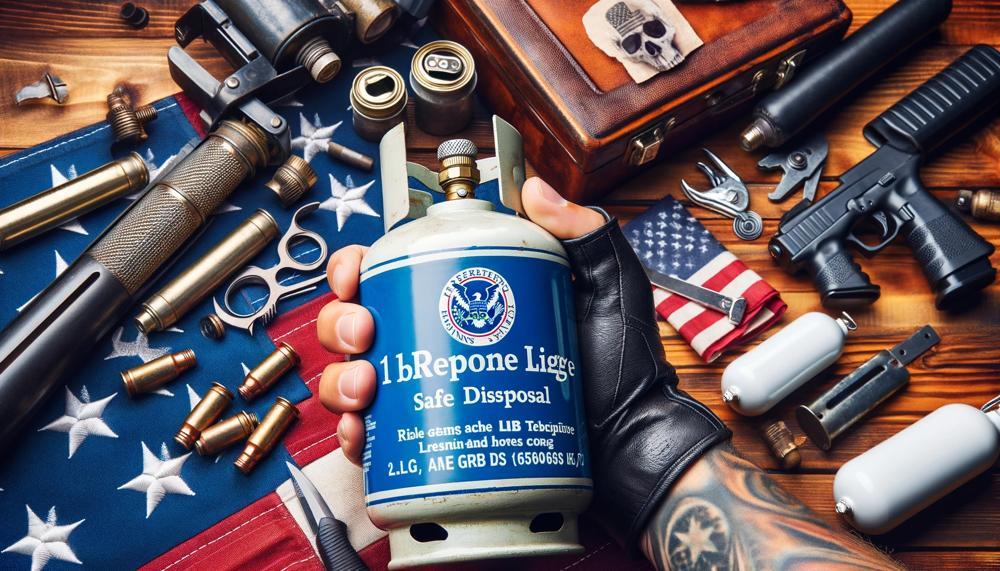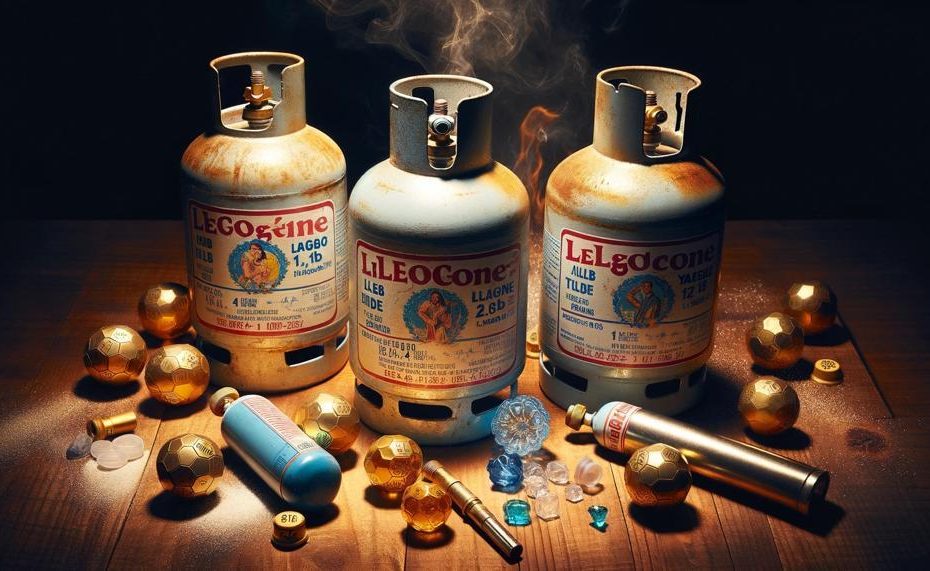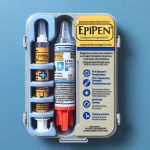As the warm weather approaches, many of us are eagerly preparing for outdoor adventures like camping, grilling, and roasting marshmallows over a cozy backyard fire. But amidst all the excitement, it’s crucial to remember the proper way to dispose of our propane cylinders once they’re empty.
So, how do you dispose of 1lb propane cylinders safely?
Here are some ways to dispose of propane cylinders:
- Hazardous waste collection site: Contact your local government’s sanitation department to find out if there are any hazardous waste collections near you. Most municipalities will accept propane tanks that are up to 5 pounds (2,300 g) at hazardous waste drop-off sites.
- Local propane tank dealer: Exchange empty tanks at any local propane tank dealer.
- SAFE Disposal Events: Dispose of tanks at SAFE Disposal Events.
- Blue Rhino retailer location: Dispose of your unwanted tank at a Blue Rhino retailer location.
- Household trash: If the cylinders are properly “burned off” with an appliance, less than 1 gram of fuel remains, meaning the cylinders can be discarded with household trash.
Now that we’ve covered the basics, let’s dig deeper into why it’s crucial to properly dispose of these small but mighty cylinders. Not only does it protect our environment from potential hazards, but it also ensures the safety of those handling the cylinders during the recycling process.
So next time you finish off that last bit of propane, remember to dispose of your cylinder responsibly.
Keep reading for more tips and information on how to safely enjoy all your favorite outdoor activities this summer.
Contents
- 1 Understanding Propane Tanks
- 2 Why is it Important to Dispose of the Propane Tanks?
- 3 Safety Measures When Handling Propane Tanks
- 4 How to Dispose of Camping Propane Tanks Safely
- 5 Where to Dispose of Your Camping Propane Tank
- 6 Alternatives to Disposal
- 7 What to Do If You Can’t Find a Disposal Option Near You
- 8 Conclusion
Understanding Propane Tanks
Propane tanks may appear simple, but they are actually intricate systems designed to prioritize safety and efficiency.
Let’s dive deeper into the various components of a propane tank and their role in storing and releasing propane gas.
- Valve: The valve situated on top of the tank is responsible for dispensing propane through a hose when needed. It is crucial to have this valve professionally installed and calibrated to prevent potential hazards.
- Level Gauge: This gauge is used to determine the amount of propane in the tank during refills. It is essential to ensure that the tank does not exceed 86% capacity due to pressure concerns.
- Pressure Relief Valve: As its name implies, this valve automatically releases excess pressure from the tank. It should only be handled by trained professionals to avoid any potential risks.
- Dial Gauge: Located beneath the tank dome, this gauge indicates the fuel level in the tank. Regularly checking the dial gauge is vital for timely refills.
- Vapor Equalizing Valve: This valve releases any extra pressure during filling and should never be looked at directly or handled without protective gear.
- Service Valve: The service valve controls the flow of propane from the tank and can shut off all gas when turned clockwise. Proper installation and maintenance of this valve by professionals are crucial.
- Regulator: To lower the highly pressurized propane before reaching appliances, a regulator is necessary. It connects to the service valve through a “pigtail” pipe.
- Combination Valve: Some older tanks may have combination valves that combine multiple functions into one system, but this design is becoming less common.
Overall, these different parts of a propane tank work together seamlessly to guarantee safe storage and release of propane gas.
It is important to handle propane tanks with care and have them serviced by trained professionals for proper disposal or refilling.
Why is it Important to Dispose of the Propane Tanks?
Not disposing of 1lb propane cylinders properly can lead to several potential dangers, including fire and explosion risks, environmental hazards, health risks, physical injuries, and legal consequences.
Fire and explosion risks are the most severe danger of improper disposal. A damaged or punctured propane cylinder can release explosive gas, causing fires and explosions that can result in severe burns or even death. It is crucial to dispose of these cylinders correctly to avoid such catastrophic outcomes.
Improper disposal of propane tanks can also have harmful effects on the environment. Propane is a flammable gas that can pollute soil and water if disposed of in landfills or open areas. To prevent environmental hazards, it is essential to dispose of 1lb propane cylinders properly.
Inhaling propane gas can cause dizziness, headaches, nausea, and even loss of consciousness. Improper disposal of 1lb propane cylinders can release this gas into the air, putting individuals at risk. To protect your health and safety, make sure to dispose of these cylinders correctly.
Improperly disposing of 1lb propane cylinders can also lead to physical injuries. Without removing the residual gas or puncturing the tank before disposal, individuals risk cuts and bruises from sharp metal edges. It is vital to handle these cylinders carefully to avoid physical harm.
Lastly, failure to comply with local laws and regulations regarding the disposal of propane tanks can result in fines and penalties. To avoid legal consequences, make sure to check with local authorities before disposing of any propane tanks.
Safety Measures When Handling Propane Tanks
When handling 1lb propane cylinders for disposal, it is crucial to follow proper safety measures to prevent any accidents or hazards. These measures include:
| Appropriate Storage | It is essential to store propane cylinders in a well-ventilated area, far from any sources of heat or ignition. |
| Handle with Care | Secure cylinders in an upright position when moving or transporting them to prevent damage and leaks. |
| Follow Manufacturer’s Instructions | Always follow the manufacturer’s instructions for proper disposal methods and safety precautions. |
| Inspect for Damage | Before using or disposing of a cylinder, inspect it for any signs of damage and dispose of it properly if found. |
| Proper Disposal | Follow proper disposal methods by contacting your local waste management facility. |
| Wear Protective Gear | Wear gloves and safety glasses when handling propane cylinders to protect yourself from hazards. |

How to Dispose of Camping Propane Tanks Safely
When engaging in camping activities, it is of utmost importance to adhere to proper safety measures when disposing of 1-pound propane cylinders. These small but powerful cylinders are commonly used for camping stoves and lanterns.
However, they must be disposed of with caution due to the potential danger of remaining fuel. To ensure a safe and responsible disposal of these cylinders while camping, here are some of the best methods to follow:
- Confirm the cylinder is empty: Before disposing of a cylinder, it is crucial to make sure that it is completely empty. To do this, check for any remaining fuel by listening for a hissing sound when the valve is opened or by spraying soapy water on the valve and observing for bubbles.
- Puncture and seal the cylinder: Once it has been confirmed that the cylinder is empty, puncture it with a nail or screwdriver and seal the hole with duct tape. This step is essential in preventing any residual fuel from escaping.
- Crush and bury or discard: After sealing the puncture hole, use heavy metal objects to crush the cylinder, making sure it cannot be used again. It can then be disposed of by burying it or throwing it away in a designated hazardous waste disposal bin.
- Connect to a propane tank: Another option for disposing of 1-pound propane cylinders is by connecting them to a larger propane tank and releasing all gas from the smaller cylinder. However, this method should only be done in a well-ventilated area.
- Recycle at a recycling center: Many states have strict laws against refilling propane tanks, making recycling the safest option for disposal. Take your empty 1-pound propane cylinders to a recycling center that accepts them for proper disposal.
It is vital to follow these methods carefully and responsibly to avoid potential hazards when disposing of 1-pound propane cylinders while camping.
Always check with your local municipality for specific guidelines on safe disposal methods in your area.
By following these steps, you can ensure the safe and responsible disposal of these potentially dangerous cylinders while enjoying your camping trip.
Where to Dispose of Your Camping Propane Tank
After a thrilling camping adventure, it is crucial to dispose of any remaining propane cylinders in a responsible and safe manner to protect yourself and the environment. Below are some viable options for properly disposing of a 1lb propane cylinder commonly used for camping:
- Check for leftover fuel: Before disposing of the cylinder, carefully check for any remaining fuel. You can do this by feeling the weight of the cylinder or listening for any hissing sounds when turning the valve. If you are unsure, it is best to err on the side of caution and assume there is still fuel present. Taking necessary precautions is key.
- Puncture and seal the cylinder: Using a nail or screwdriver, puncture the cylinder in multiple places to release any lingering gas. Then, use a file to flatten the punctured areas. Finally, securely seal the cylinder with duct tape to prevent any potential leaks.
- Crush and bury or discard: Another option is to crush the cylinder using heavy metal objects like a hammer or car tire. Once flattened, you can bury it in a designated area or safely dispose of it in your regular trash.
- Connect and empty: Some facilities may allow you to attach the empty cylinder to a larger propane tank and release all remaining gas. Afterward, be sure to properly seal and dispose of the empty cylinder.
- Check with local recycling centers: Certain local recycling centers may accept pressurized tanks or offer refilling services. Contact your local municipality office or search online for designated centers near you.
- Understand state regulations: It is crucial to be familiar with state laws regarding refilling propane tanks before attempting to do so. In some states, refilling 1lb cylinders is strictly prohibited due to safety concerns.
Remember, if you are uncertain about how to dispose of hazardous materials, always consult your local municipality office for guidance.
Alternatives to Disposal
There are various eco-friendly alternatives to disposing of 1lb propane cylinders. Let’s delve into each of them below.
| Alternative | Description | Benefits |
| Puncturing and Sealing | This method involves piercing the cylinder, allowing all the gas to escape, and then securely sealing the hole with a welding torch or soldering iron. | – Prevents the release of harmful gases into the environment – Safe for waste workers – Allows for safe disposal in regular trash |
| Crushing and Burying | You can crush the cylinder using a hydraulic press or heavy machinery, and then bury it in a designated landfill or disposal site. | – Prevents gas leaks – Aids in reducing waste in landfills – An environmentally-conscious disposal method |
| Connecting and Emptying | This method involves connecting the cylinder to a larger one or a propane-powered appliance and emptying the remaining gas. | – Allows for efficient use of remaining gas – Minimizes waste – Safe for disposal in regular trash after being emptied |
| Recycling at Community Solid Waste Transfer Stations or Hazardous Waste Facilities | Some communities offer recycling programs for 1lb propane cylinders at transfer stations or hazardous waste facilities. | – Promotes recycling and responsible disposal practices – Prevents harm to the environment – Reduces negative impact on waste management systems |
| Propane Exchange Programs | Retailers like Home Depot, Lowe’s, and Blue Rhino offer propane exchange programs where customers can trade their empty cylinders for filled ones. | – Promotes recycling and responsible disposal practices – Provides a continuous supply of propane – Safe and convenient disposal method |
| Understanding State Regulations | It’s important to understand state regulations regarding the disposal of propane cylinders, as some states have specific guidelines for proper disposal. | – Ensures compliance with state laws – Helps prevent harm to the environment – Promotes responsible waste management practices |
By incorporating these environmentally-friendly alternatives, you can safely and responsibly dispose of your 1lb propane cylinders without causing any harm to the environment.
It’s crucial to follow manufacturer instructions for use and disposal, as well as adhere to any state regulations, in order to minimize negative environmental impact.
Additionally, always handle propane bottles with care and avoid puncturing or cutting them as this can release dangerous gas.
What to Do If You Can’t Find a Disposal Option Near You
If you are unable to locate a disposal facility nearby for your 1lb propane cylinders, there are still several alternative options available for safe and responsible disposal. These options include recycling centers that accept pressurized tanks and refilling the tank according to state laws.
Recycling Centers:
One way to properly dispose of your 1lb propane cylinders is to take them to a recycling center that accepts pressurized tanks. These centers have the necessary equipment and protocols in place to safely handle and recycle these types of tanks.
They will puncture and empty the cylinder before recycling it, ensuring that it is disposed of correctly without any harm to the environment.
Refilling the Tank:
Another option is to refill the tank in accordance with state laws. This option may not always be viable, as some states have laws prohibiting the refilling of propane tanks by anyone other than a licensed professional. However, if it is allowed in your state, this is an environmentally friendly way to dispose of your 1lb propane cylinders.
By refilling the tank, you avoid wasting any remaining gas and can continue to use it for its intended purpose.
Contact Your Local Municipality:
If you are unsure about how to properly dispose of your 1lb propane cylinders, reach out to your local municipality for guidance.
They will be able to provide you with information on any specific regulations or guidelines for disposing of hazardous materials in your area.
Conclusion
In conclusion, the safe disposal of 1lb propane cylinders is crucial for both our well-being and the health of our planet.
These small but powerful tanks should never be carelessly discarded in the trash or recycling bin, as this can result in serious dangers such as fire and explosion risks, environmental pollution, health hazards, physical harm, and legal consequences. It is imperative to dispose of them properly at a certified propane cylinder recycling facility.
Some local hardware stores and waste management companies also offer convenient recycling services for these cylinders. Additionally, it is essential to understand how propane tanks function and follow necessary safety precautions when handling them.
Always check for remaining fuel, puncture and seal the cylinder before disposal, crush or empty it correctly, or recycle it at designated facilities. If you are unable to find a disposal option nearby, seek guidance from your local municipality.





